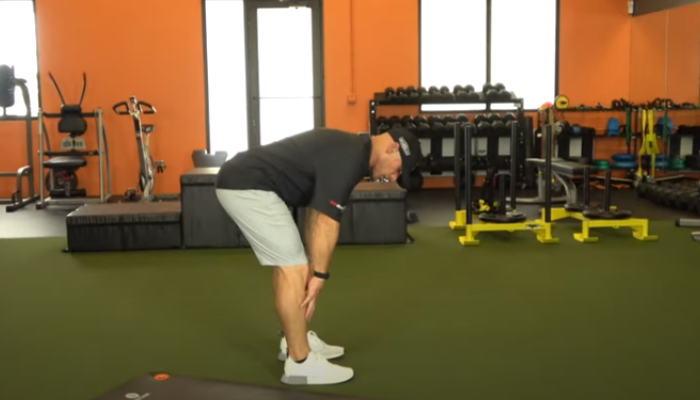
Suffering from lower back pain or chronic back tightness?
In modern society, back problems are, unfortunately, an all-too-common issue. Too many of us spend long years sitting at work or at home. When you add little to no exercise into the mix, our bodies deteriorate. They start broadcasting warning signals (pain). The good news is, it’s not too late to make changes.
While we are not orthopedic surgeons, neurosurgeons, physiatrists or physical therapists*, our fitness coaching team has almost a century of experience helping people of all ages reduce and eliminate lower back pain. Pain is our body telling us something is wrong. When it comes to our lower backs, more often than not, pinched nerves -- usually from poor posture -- and stiff muscles are the primary contributors to pain in the lumbar spine (lower back).
In this article, we’re going to talk about a handful of stretching exercises that can be helpful for golfers, who are more prone to lower back pain due to the nature of the golf swing. Please note, if your upper back (thoracic spine) is in pain, we’ll cover those types of exercises in a future article.
Playing Golf Isn’t All Fun And Games.
For someone unfamiliar with golf, it might seem like an easy sport. You swing a light club at a tiny ball, then you walk to where your ball landed (because you’re walking instead of driving, right?) and do it again. The truth is, golf places a lot of strain on your body. The golf swing itself is one of the most complex movements in all of sports. You’re engaging your entire body: strength, flexibility, balance, your brain...everything!
If your body is rigid and it’s been years since you did a stretching exercise, then you risk injuring yourself. Especially your lower back. The coil of a balanced backswing and high-speed rotation into impact can present a lot of stress. The twisting motion can cause some strain and potential damage if your body is not prepared -- if your muscles, ligaments and tendons are not prepared to support each other.
Our bodies are like a machine. If one part is performing badly, it affects the rest of the machine. It can cause damage to other parts of the machine. Even if you exercise regularly, not all routines are designed to support your love of golf. The wrong exercises can sometimes even increase your risk of developing lower back pain.
There’s no shortage of exercise “gurus” and programs out there. In fact, many mainstream fitness programs need some wacky idea or routine just to stand out. Many of these exercises are just plain silly, designed to sell programs, not give you results. Many exercises are designed to “bulk up” your muscles. While there are benefits to having bigger muscles, they tend to reduce your range of motion and increase your stiffness.
Golf Fitness for Golf Enthusiasts
When you’re looking to improve your body for a specific activity -- whether it’s running, swimming or playing golf -- take advice from experts in their field. Study swimming from swimming experts. Get a running coach to help improve your running mechanics. Likewise, you should be getting golf fitness instruction from professional golf instructors.
Because we’re on the subject of lower back pain, we’re going to show you a few stretching exercises designed to reduce your pain and improve your golf game at the same time.
1. Ten-Two Roll
This exercise is designed to slowly build up your lower back flexibility. These are passive stretches and mobility moves and there is very little risk in hurting yourself. What you’ll need is an exercise ball (55 centimeters works best) and a soft mat to lay on. If the ball is too big or too small, you’ll struggle to get your legs to 90 degrees. Here’s how you should look when performing this stretch:
The stretch is simple: roll your legs back and forth, left to right. Great trunk rotation is critical for golfers and those suffering from lower back pain. Just make sure you’re in complete control the entire time. You don’t want the ball to force your stretch further than you feel comfortable doing.
How long or how many reps should you perform? Listen to your body. If 10 is too much, do less. If 10 is too little, do a few more. The important thing is to not push your body too far. Be patient, follow the routines and results will follow soon enough.
You can also watch our video below to get more detailed instructions on each exercise.
2. One-Leg-Over Stretch
This exercise is similar to the one above with one key exception: you place one leg flat on the ground while rolling the ball over it with your other leg. This is what it should look like:
Now we move the ball over our leg. Stretch to the furthest point you can while maintaining control. If you’re just getting started, be careful. Don’t go too far and risk further injury.
Return to the starting position and repeat the ranges of motion. As a side benefit, if you have shoulder pain (rotator cuff injuries), then this exercise will also help relieve some of that pain.
3. Midsection Lift
While stretching is important, you also want to make sure the exercises are strengthening your muscles. Since you’re already on the floor, do a simple hip flexors exercise. Here’s the position:
Now raise your midsection up… like someone has a hook on your belt buckle pulling you up.
Hold this position for a few seconds and drop back down. Rinse and repeat.
Again, listen to your body. Don’t go overboard on the number of repetitions you’re doing. Ease into things. Especially if it’s been a while since you’ve exercised, or if you’re still feeling back pain. These exercises are not designed to bulk up your muscles, their goal is to loosen up your lower back and help reduce any pain from muscle stiffness you’re suffering from.
4. Hamstring Stretch
Remember the point that our bodies are like machines and each part is designed to support other parts? When one part is broken, it affects the rest of the parts...most people don’t know this, but a tight hamstring can cause lower back pain. Here’s the position:
Spread your feet shoulder width apart and bend your knees slightly. Then, reach down to touch your toes. Take your time and control the movement.
Now, you may be thinking to yourself: “Ugh, I don’t want to exercise, I just want to play golf and have fun. Stretching and exercising is boring!” Here’s the deal. If your body is in better shape you’ll be able to play more golf more often and enjoy every minute of it. But best of all? You’ll feel better the next day. You don’t have to worry about being sore all over and getting out of bed won’t feel like a herculean task.
Swinging a golf club should be a fun activity. If you’re always in pain, either during or after a round of golf, that’s your body telling you something is wrong. It’s telling you, “Maybe it’s time to take up a training program.”
If you’re looking for a comprehensive golf fitness program, we're here to help with two great options to train with us from the comfort of your own home. Follow this link to learn more.
In the meantime, here's Coach Joey D's step-by-step instruction for today's movement patterns and exercises. Enjoy!
Team Joey D Golf
© 2020 joeydgolf.com

